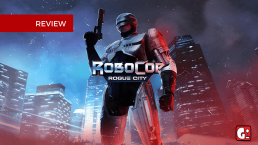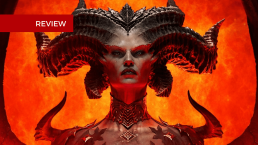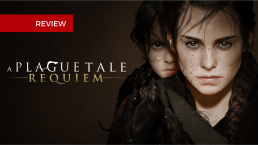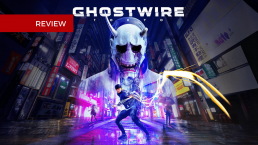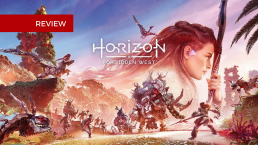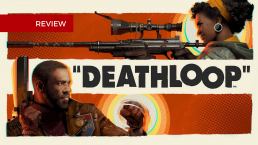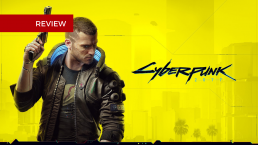Review | RoboCop Rogue City
I am a child born in the eighties. The time when titles such as Star Wars, Indiana Jones and Robocop (made by none other than our own Paul Verhoeven) saw the light of day. So a game with these names always deserves my attention. Will this Robocop take me back to my teenage years?
Robocop: Rogue City centers on Alex Murphy, a cop who barely survives an attack by drug criminals, and has had to pay for it with basically everything. His entire body has been replaced by a robotic prosthesis and all that remains is his face. The robotic Alex Murphy now patrols the streets of Detroit, a city that appears to be run by a Corporation (OCP), the makers of Robocop. The underlying plan is bigger, replacing old Detroit with Delta City, driving poor residents out of the city.
The story in the game is new. It has no familiar parts from the films. A new enemy has appeared and you investigate what is going on. You scan crime scenes to look for clues and tackle groups of criminals. We see many familiar faces from the film in the game, such as his partner Anne Lewis, and everything breathes the atmosphere of the film. One-liners and Robo’s cheesy and awkward humor.
It is a story that will certainly not win any Oscars, but it is the perfect motivation to go all out as a mechanical officer. And the game does that while remaining surprisingly faithful to the source material. A lot of well-known characters are also present, the iconic sound effects from the original films thunder from your speakers and the icing on the cake is perhaps Peter Weller who is present to once again provide the voice of RoboCop.
The game does not shy away from secretly hinting at some social criticism, just like the original liked to do. But the human side of the cyborg also gets enough screen time. For example, RoboCop experiences various flashbacks to the time before the attempt on his life and he talks several times with a psychologist who gives his human side space to shine. It is clear that the developers have a clear passion for the license and that authenticity shines through on all sides.
The key question then remains: does such an authentic basis also translate into entertaining gameplay? That answer is a bit more twofold. Rogue City does a number of things very well, but there are also a few clear caveats that detract from the gaming experience. The core of that gameplay, shooting down hordes of criminals, is by far one of the highlights of the game. Armed with your trusty Auto 9, you will blast kilos of lead through all opponents. RoboCop doesn’t do subtle, so taking cover is rare.

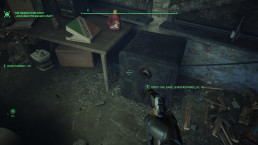
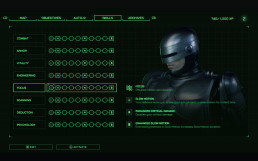
Often you run straight into the crowd and shoot everyone without hesitation. The punch that your weapons deliver and the sound that the Auto 9 makes with every volley fired will never bore you for a moment. You can fine-tune your playing style as the game progresses with skill points that you can spend to, for example, do more damage or improve your armor.
But the Auto 9 itself can also be customized with various circuit boards and upgrades, which can be quite drastic. For example, one circuit board ensures that you never have to reload, at the expense of the accuracy of your shots. Another circuit board does exactly the opposite and turns your gun into a real sniper, with single shots that do much more damage each.
It gives the shooting that extra depth that benefits the gameplay, especially if you have been hopping around the digital streets of Detroit for ten hours. It is the depth and variety that is sometimes a bit lacking further in the game. In addition to all the lead shooting, as RoboCop you also go to the streets a lot to do old-fashioned detective work.
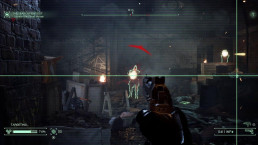
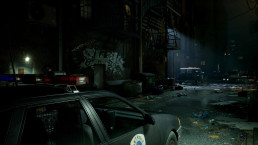
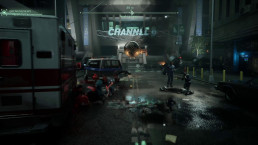
The game’s semi-open world structure gives you the opportunity to explore Detroit at your leisure amid the violence and interact with the countless side missions the game offers. The problem here is that the city itself feels quite barren and deserted at times. Apart from a handful of NPCs, you will find little excitement in the world of Rogue City, which is a shame. How fitting would it be to have to solve a street fight or shoplifting as Robo.
The missions you are presented with are often very simple in design. Walk from point A to point B, talk to person It is not very special and sometimes even a bit boring. Moreover, the conversations you have with the residents of Detroit often feel superficial and have little impact. You are given the opportunity to choose dialogue options more than once, but the consequences of those choices are hardly noticeable in the further course of the game.
Only at the end are you presented with the consequences (the game has multiple endings), but there too the differences are very small. As a result, RoboCop Rogue City sometimes feels a bit too superficial and that is a shame, because the first impression is so strong. It is also a little later in the game that the technical finishing is lacking in many areas. Voices are not always synchronized, the animation of characters is sometimes very wooden and cutscenes stutter and have clear blocky artifacts. Although you would think that this might have been done on purpose, it is the 80’s baby after all!
RoboCop Rogue City is out for PlayStation 5, Xbox Series S and X and PC.
Score:
7,5
+ Authentic 80’s feel
+ Beautiful graphics
+ Shoots away nicely
+ Nice and violent, like the movies
– Skills, “builds” and consequences not clearly explained
– Game has some performance issues wile on Graphic mode
Review | Assassin's Creed Mirage
Since the first Assassin's Creed, we have been more than sixteen years and almost as many main parts in the series. Nevertheless, we have never seen a game like the first part again. The sequels kept getting bigger and bigger, and became less and less about playing an assassin. Assassin's Creed Mirage goes back to the basics of the series.
Assassin’s Creed Mirage is set in Baghdad at the end of the ninth century. This time the leading role is for an old acquaintance: Basim. When we meet him in Assassin’s Creed Valhalla, he is already a seasoned assassin with a double agenda. In Mirage he is still a young street rat, who spends his days doing some menial work until something happens that suddenly makes him join the mysterious Hidden Ones.
Yet Ubisoft manages to make the most confusing intro ever in the series. In the first few hours, names and locations are thrown around, and the game jumps from one topic to another.
When the game really starts, Assassin’s Creed Mirage is a piece of cake. The game is built on the same foundation as Valhalla, Odyssey and Origins, but without a lot of baggage. So the same controls and menus, but not a hundred thousand different weapons, skills and question marks on an intimidatingly large map.
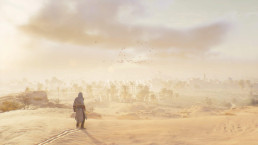
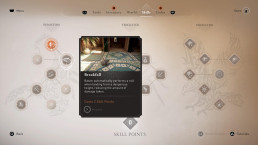
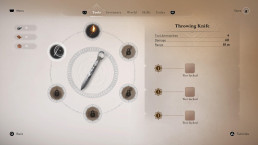
Without axes, beards and boat trips, Assassin’s Creed is once again about playing assassin. The extermination of members of The Order was of course still in the more recent parts, but had actually become more of a side issue. Here that system is magnified. You must first track down and unmask each target before you can strike.
That detective work has more meat on the bones in Mirage than in the previous games, although you still don’t have to be called Sherlock Holmes to solve a case. Actually killing your target is a new challenge. There are always a few different approaches to explore, but ultimately they all have the same ending, the end of your target.


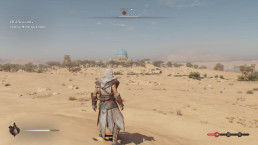
Assassin’s Creed Mirage therefore keeps the momentum going, but many murders also feel rather interchangeable due to the relatively high pace. You rush from target to target, without ever really thinking about anything. A longer adventure in a large bazaar stands out in a positive way and brings out the best of Mirage. The mission carefully builds up to taking out your target, and is also set in one of the most authentic locations in the game.
The colorful spices and carpets in the stalls pop from the otherwise sandy brown screen, while chromatic aberration gives the whole a warm, almost dreamy appearance. All this makes Baghdad very attractive.
Other missions felt more routine in comparison, like stabbing a random soldier on the streets of Baghdad. The game could have slowed down the tactical throttle a bit more often, in order to really highlight the atmospheric locations and the actual assassinations.
Unfortunately, it doesn’t help that the targets in question are incredibly interchangeable. From the start of the game, people point very loudly in their direction and shout ’these are the bad guys, they have to die!’, and no one makes a critical comment. As a player you have to get that motivation from previous games. The existence of the Isu/Those Who Came Before is reduced to a trivial fact that no one really notices, and nothing is done with Basim’s double agenda from Valhalla.
It is an art to make a good prequel, as the ending point has already been determined. Mirage unfortunately misses the mark in that area and above all adds nothing to the existing canon of Assassin’s Creed. Mirage does add something to your general development: the brief history lessons about certain buildings, the city and local cultures are finally an integral part of the game again.
Assassin’s Creed Mirage is now available for PlayStation 4, PlayStation 5, Xbox One, Xbox Series X/S and PC. The game will also come to iPhone 15 Pro in 2024.
Score:
7,5
+ Tracking down targets provides excellent structure.
+ It’s finally all about assassinations again.
+ Baghdad is very atmospheric.
– Occasional Frame drops in busy areas.
– Negligible story.
Review | Diablo IV
The first time I heard the sound, I knew I was in trouble. You know it, that swishing sound in Diablo when you open a chest and the loot flies through the air. A sound full of possibilities, endless possibilities. What could i get next, how could I improve, how could I become better?
I hadn’t touched Diablo in a few years, but when I heard that sound in Diablo 4, I knew it: the game immediately got me all over again. Diablo can motivate you like no other to keep playing in order to assemble ever better equipment, unlock ever better skills and tackle and hopefully defeat increasingly difficult bosses. This fourth part further hones that into an irresistible gameplay loop.
It’s a delicious feast of an endless stream of enemies and interesting skills to unleash on them. Diablo may sometimes feel like mindless clicking, but especially on higher difficulties you really need tactics. Especially if you play with several people at the same time, you can conjure up the entire screen with whirlwinds, fireballs, skeletons or landslides.
You start your journey by choosing one of the five available classes. Whether you go for the Barbarian, Druid, Rogue, Necromancer or Sorcerer, the skill tree allows you to completely adapt your character to your own playing style. The choice between these skills is better than ever because it offers a lot of flexibility without giving you too much freedom.
I myself chose the Necromancer, which immediately appeals to me. With a simple click you conjure up an army of skeletons at your feet that do what you want, attack whoever you want. From a distance I hurl bonespikes at the enemy and let my undead hordes finish the job. At later levels you can summon even bigger undead creatures including a golem.
Casting through the hordes of monsters with my karate was an immense pleasure. What makes it even more fun is that for each of the above skills I also had three or four other choices. For example, maybe you don’t want hordes of undead minions around you, but rather solve it alone. Or maybe you prefer to work with blood magic, kill your enemies and heal yourself in one blow. Each class is very well put together in that way, with at least four or five workable builds to go for.
Each choice also feels much more important. In Diablo 3 you could switch skills at any time, but in part 4 that comes with a price tag. In the beginning you don’t have to pay that much gold to ‘respec’ a skill and make a different choice, but later on it will cost a considerable amount of money. So you don’t have to be afraid of a wrong choice during the first levels, but you do have to make a clear decision in the end.
That may seem restrictive compared to the previous part, but it makes you feel much more connected to your character and his or her skills. You can also no longer turn off all your AoE skills just before a final boss, so you really have to make a balanced build. It’s a perfect balance between the freedom to make a wrong choice and the coercive hand to come up with a good tactic yourself.
The large amount of loot has also been improved in a way that was not obvious. Diablo 3 was packed with sets of awesome weapons and armor that you could combine for extra power. This seemed really cool, but also had a major drawback: some sets were clearly the very best, so most players only wanted those sets. That doesn’t offer much flexibility.
Diablo 4 doesn’t choose to make equipment even cooler and stronger, but instead scales back and makes it more flexible. You can improve almost anything you find at a blacksmith shop, change the properties of each piece of equipment, or even turn rare items into legendary pieces of equipment with special abilities of your choice. So the choice is no longer just: is this new weapon better or worse than what I’m using now? But also: can I make this new weapon even better, so that it is still useful? Only at the higher difficulty levels do you now encounter unique objects that offer some extra power, and even those often have limitations, so that the ‘ultimate’ build cannot be simply sketched out.



A change that immediately catches the eye is the dark style of this latest part. Some fans were shocked by the colorful environments in Diablo 3, although I was not one of them. I was charmed by the style, something different from the always so dark worlds of Diablo.
The game is beautiful and the new style often comes into its own. Environments are full of details, which can often be broken. The lighting in particular comes into its own, with lanterns swaying in the wind and bathing the dark streets in a wavering light.
However, the gothic style covers the entire game with a heavy blanket of dullness, which also makes everything feel a bit the same. In any case, the environments are not very creative and it mainly seems to be a list of hangouts for goths: a dark lawn, dark cave, dark desert, dark snow field, a castle that is on fire, but is still dark. I was never stimulated by anything new. They are mainly places that we have also seen in previous Diablos.
The story isn’t very impressive either. A bunch of fools summon Lilith, the daughter of Mephisto, who has a sinister plan to become more powerful than ever. You mainly follow her for the rest of the game, so that you never really meet her and are always too late to intervene. You especially get into trouble with the aftermath of her plans and the monsters she has summoned.
Normally I’d say if you’re playing Diablo for the story, you’re doing it wrong. But part four puts extra emphasis on it, with many more cutscenes and dialogues. That’s quite nicely done, with some emotional moments, but the game’s engine can’t really handle it. The camera is made to hover over the action, not to zoom in on someone’s face.
As a result, some videos are quite ugly. In any case, they are in stark contrast to the game’s CGI intro, which is so beautiful that it could have been shown in the cinema. There are a lot of cutscenes that have clearly been given more attention, but in normal conversation characters are sometimes wooden and environments suddenly much uglier up close.
The other big change: Diablo 4 is an online game. That works out differently, and depends a bit on your gaming taste. In any case, we do not yet know how well the servers will hold up, but that will in any case be fine in the longer term. A bigger downside is that the game cannot be paused. That’s quite annoying if you’re just busy in a dungeon and the doorbell rings, or your cat pukes on the carpet. Since you can be attacked at any time, only in villages do you feel safe enough to go to the toilet.
On the positive side, the open world feels much more social as a result. Everywhere you see other players walking around in villages, or you meet them at one of the random events on the map. It feels good to go into battle together, overcome a tough challenge and then choose your own path again. Although of course you can always become friends or join each other’s clan.
Diablo 4 is already a pleasure on your own, but especially with multiple players in a group of up to four, the game really comes into its own. The interplay between the different classes and the effects of all those different skills racing across the screen: it’s a pleasure to watch and to control.



Diablo 4 is a gigantic game, with more elements than we can describe in one review. The best part is how the game seems to find a solution for all the little problems that could ruin your gaming experience.
In addition to the aforementioned smart things about loot and respecting builds, for example, it does its best to make the open world manageable. Everywhere you will find dungeons, side missions and cellars full of monsters, but of course you don’t have to go through everything. However, optional dungeons grant Legendary abilities that you can craft on your equipment. Fortunately, you can see on the map which skill you find in which dungeon, so that you don’t waste hours in dungeons only to get skills that you can’t use with your class.
At the same time, the game knows how to motivate you to spend more time in the open game world. Each area discovered, mission or dungeon completed fills a reward meter, unlocking crucial items for that region of the world map. Consider, for example, extra skill points or more XP, but also an extra health bottle that you always carry with you. This way you are constantly encouraged to stray from the path and visit the optional villages, characters and dungeons.
The game is full of these kinds of elements. Just when you get the feeling that the open world is getting very big and difficult to navigate, you get a horse at your disposal to race through it a bit faster. You can put a pin on your map and the fastest route to get there will automatically be shown on your minimap. Anyway, you can teleport to any village you’ve been to at any time, sell your inventory and then go back to where you left off. These are all elements that reduce the friction of this sometimes overwhelming game and make it endlessly playable.
Of course a game like Diablo 4 is difficult to review. I have now put in a decent amount of hours and have only just got a taste of the game, in which you always complete new dungeons and other challenges at higher levels of difficulty. I have seen a solid basis there to want to continue playing the game for dozens of hours, but my playing time is certainly too little to know whether this will remain fun and challenging for hundreds of hours, let alone whether all classes will reach level 100 in their ultimate form be well balanced. Also, the first season doesn’t start until July, so I can’t tell you if the upcoming Battle Pass with cosmetic items will ruin the gameplay.
What I do know is that Diablo 4 lays an unprecedentedly good foundation that fans can use again in the coming years. The game seems even better balanced, loot has been cleverly adjusted and your heroes and gear feel more personal as you have to think more about your build.
Score:
9,0
+ Weighty choices in character development
+ Open game world that rewards curiosity
+ Loot system feels well balanced
– Story and environments are a bit disappointing
– Game cannot be paused
Review | God of War Ragnarök
“Why did you want to do this mission with me, father?” Atreus asks after one of the many optional tasks. Kratos growls a bit, but doesn't dare to show the back of his tongue. It's Mimir, the severed head full of funny stories, who finally breaks the silence: "He just wants to spend some more time with you." It is also a perfect metaphor for God of War Ragnarök.
Because yes, the successor to the 2018 reboot essentially feels like more of the same. But that God of War was so good that spending more time in this world is absolutely no punishment. If you really don’t want to know anything about the game, read this one sentence before closing this page: anyone who enjoyed the previous game will be completely satisfied with Ragnarök.
But Mimir’s quote also applies in another way, namely because of the emotional underlay. Ragnarök focuses almost all his arrows on the story and the development of the relationships between characters. Scenes seem to have been written on purpose to make you cry, and dammit, they work damn well too.
God of War Ragnarök starts in the same place as the first part, namely at home. Kratos and Atreus have been hiding for a few years because everyone is out to get them. Freya is angry that they killed her son Baldur, Thor is angry that his sons did not survive and supreme god Odin is angry because… well, because Ragnarök is coming, the prophesied end of the world.
Atreus is tired of waiting and eager to discover who he is and what part he plays in all the prophecies. Shouldn’t he be saving the world, or at least helping with something? What follows is an immersive adventure in which everyone learns something about themselves. Can you break free from prophecies and expectations to become who you want to be? Are you in charge of your own destiny?
In this grand pantheon of quarrels between gods, everything feels very personal. Kratos is no longer as he used to be on a murderous crusade to kill all the gods, but is willing to talk things through and avoid violence, if this keeps his son safe. The growth that Kratos is experiencing as a human being is enormous, sometimes even unbelievably large. Not that he is now whining endless monologues, but the Kratos who only wants to drink blood is definitely a thing of the past.

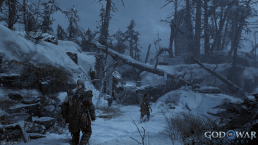
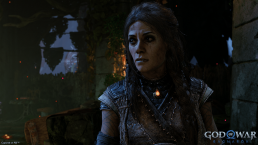
The focus is on personal interests and motivations, which impressively seeps through even in the side missions. The game again has a number of open hub worlds, in which you can explore somewhat freely. Ragnarök isn’t an open world game all of a sudden, but just like in 2018’s God of War, there are optional areas where you can find additional content if you feel like it.
You’ll be triggered more than ever to sink your teeth into it, as you’ll be rewarded with bits of story and emotional moments surrounding the main characters. For example, in the dwarf kingdom of Svartalfheim, Mimir asks you to dismantle construction sites, because in the past he helped Odin turn the dwarfs into slaves of sorts. He wants to correct his mistakes from the past, which adds an extra layer to this fairly simple job.
In any case, the many characters are the biggest plus of the game. Returning favorites such as Mimir and the dwarfs Brok and Sindri, as well as new friends from the gods realm impress. The acting is top notch, with Danielle Bisutti as the highlight. Her broken Freya swings between limitless anger and heartbreaking grief, and is a joy to watch.
In addition, the portrayal of Odin is a bold choice that turns out fantastic. Between large and taciturn muscle masses like Kratos and Thor, Richard Schiff plays the supreme god as some sort of mob boss who relies more on his brain than on sheer strength. It makes him an endlessly intriguing antagonist who is always two steps ahead of you.
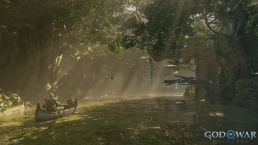
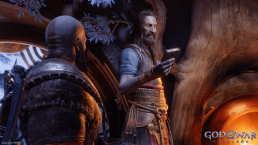
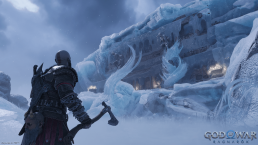
This story is again brilliantly portrayed by fabulous camera work, where no cuts are ever made in scenes. Everything is one take, which makes the adventures of Kratos and Atreus even more personal. You really feel like you are staying by their side and going out together. It also provides the necessary calmness, because the camera rests on faces for a long time. When there is an Important Conversation, you get all the nuances on the faces of the actors.
This time, the camera gets a little more space to capture other storylines as well. Ragnarök has a lot of creative tricks in store to portray the whole in a surprising way and to let everything melt together perfectly. Director Eric Williams deserves a big compliment for his sometimes daring, but certainly successful choices in the script.
You might notice that this action-adventure review isn’t about action for 12 paragraphs. This game relies so much on the story that the developers themselves sometimes almost forget that there is still a fight to be made. Quick, throw another group of meaningless enemies at the player! You are regularly confronted with small fights, just because the previous fight was so long ago.
That sometimes breaks the pace of the game, especially if it starts to feel like a must. Some battles and environments are even exactly the same as in the previous game. “Hey, remember this great enemy? Well, there it is again!” Fortunately, the total amount of different enemies has increased, making the game more varied in the end.
It shouldn’t spoil the fun too much, especially because the combat is so very good and tight. Little has actually changed since the previous game, but that’s not a bad thing at all in this case. The ax and double chain swords feel great as ever. You have total control over Kratos and all his moves, the controls never get in your way and the combos flow effortlessly from your fingertips.
New additions to your arsenal are welcome, but not a major revolution. For example, you can now charge your weapon before starting a combo for an extra dose of ice or fire. Later in the game you can choose to focus more on long-range combat, but hey, who wants that when you’ve got your hands on those iconic melee weapons?
You also have little time to get bored of the combat, because the game contains more epic moments and battles than before. Although Ragnarök, like his predecessor, has a slow start, the journey is more than ever filled with memorable confrontations.
Despite the above criticisms, God of War Ragnarök is a beautiful game that feels epic and grand in everything. The game is finished to perfection, all animations and details are correct and bugs are hardly or not present at all. The worlds are breathtaking at times, full of small details that bring the game all the way to life. We might have liked to see a bit more of some environments, because not all areas can be explored at your leisure.
But you really can’t complain about a lack of content here. The story rages across your screen in about twenty hours, but if you also want to explore all optional missions, you will certainly lose twice that, and maybe even more.
According to the developers, this God of War series will not be a trilogy and Ragnarök is the closing of this story. Strangely enough, it does feel like a trilogy. The game is so packed with surprising story moments that it feels like you’ve played two entire games in one. As if the studio had planned the story of a trilogy, but crammed the last two parts into one fantastic package.
Lesser gods would collapse under their own weight in such a case, but with Ragnarök that is absolutely not the case. The game is overcrowded, in the most positive way. It brilliantly weaves together all of its storylines and grandiose action, never having you huffing and puffing at the clock. After thirty hours of playing, we just want to spend more time in this world. Fortunately, there is still plenty to do.
God of War Ragnarök is available for PlayStation 5 and PlayStation 4. For this review, the game was tested on a PlayStation 5.
Score:
9,5
+ Combat remains excellent.
+ Beautifully beautiful and compelling.
+ Phenomenal and emotional acting.
+ Great story, creatively portrayed
– Puzzles slow things down.
– A bit too linear at times.
Review | A Plague Tale: Requiem
After the excellent A Plague Tale: Innocence and Microsoft Flight Simulator, Asobo Studio has proven that this still relatively unknown studio is not only extremely versatile, but also terribly talented. With A Plague Tale: Requiem, the French developer once again exceeds expectations and demonstrates that it has much more to offer.
Six months after the events of A Plague Tale: Innocence, Amicia and Hugo are still looking for a way to get the Macula curse out of Hugo. Their journey takes them to Mediterranean Provence, an area at the southeastern tip of France. Everything seems like a piece of cake, until sister and brother once again have to flee from the rats that seem to follow them everywhere.
The focus in Requiem is more on older sister Amicia. She has since embraced her role as Hugo’s protector and made peace with the fact that their world and lives will never be the same again. Amicia is ready to fight. Against the world, against fate and also against herself.
That fighting spirit is not only expressed in her emotions, but also in her behavior and thus the gameplay. Where A Plague Tale: Innocence mainly revolved around sneaking around and avoiding confrontations, Amicia hits back hard this time. The young lady strangles unsuspecting soldiers with her slingshot, throws them off her with a knife stab and, as icing on the cake, this time she is equipped with a crossbow with which she effortlessly pierces enemies.
That doesn’t mean that A Plague Tale: Requiem has suddenly become an action game. Knives are disposable, but can also be used to break open chests with upgrade materials, so you have to consider how you want to use them. While your crossbow is very useful in a tight situation, arrows are scarce and reloading is slow. And no matter how fierce you play, a single blow from the enemy can be fatal. So you still need to be on your guard.
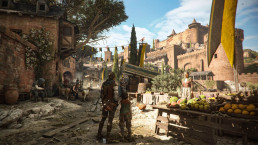

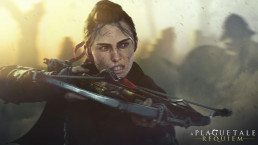
Still, the game encourages diverse playstyles by giving Amicia new abilities depending on how she handles stressful situations. If you use an aggressive playing style, Amicia will also become more combative. If you are mainly a prowler, her footsteps become more silent. The effective use of alchemy to eliminate enemies is also a path that Amicia can take.
The game offers enough freedom to try out those different play styles. While you still have to get from A to B, there’s plenty of ground to explore in between and there are multiple ways to get to your destination. Being spotted is no longer a guaranteed game over, not only because Amicia bites off her easier, but also because you have a lot more space at your disposal to get away and try a different approach.
If you do get caught, you will automatically restart with the most recently created autosave. There’s no shortage of checkpoints, but it’s frustrating that you can’t save yourself. A poorly timed checkpoint sometimes meant we had to listen to the same dialogues over and over, or craft ammo every time we rebooted. It not only ruins the enjoyable pace of the game, but also the fun. Fortunately, these moments are rare.
Your companions, such as Hugo and the young alchemist Lucas, are also an important part of Requiem. Each ally has its own specialty that matches one of three playing styles, allowing you to explore all possibilities naturally. Hugo is no longer the helpless babysitter, but makes himself useful by sending the rats directly at his enemies. In addition, the new additions to the cast are interesting, outspoken characters with enough depth. They contribute not only during confrontations, but also as the much-needed emotional support for Amicia and Hugo.
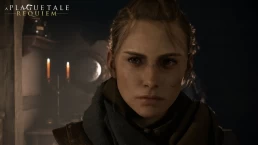
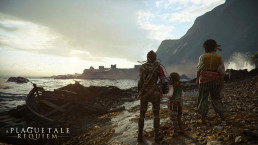
Like its predecessor, A Plague Tale: Requiem is a two-faced game. There are peaceful moments, such as when you pet a goat with Hugo for the first time, play fairground games or simply admire the sunny Provençal countryside. These hopeful moments are full of wonder, but are always temporary. As long as the Macula is still running through Hugo’s blood, it’s only a matter of time before the rats spit through the paving stones and devour all the life around them. Then A Plague Tale shows its other, repulsive side.
Whether it’s a bustling market or the pulsating heart of a rat’s nest, the sublime graphics and ditto soundtrack always come together to create an atmospheric whole. The even light of A Plague Tale: Innocence gives way to more dramatic lighting, while Unreal Engine 5 does a great job of realistic rock formations and dense forests. Olivier Derivière completes the overall picture with a chilling soundtrack full of atmospheric violin playing that is sometimes so intense that you feel the strings into your bones.
Once they show up, the rats are another not to be underestimated hurricane of pitch-black violence that spreads death and destruction everywhere it goes. Thanks to the power of the current generation of consoles, they are even more impressive, appearing in the tens of thousands at the same time. Like a deadly tsunami, they engulf settlements, leaving behind only bones, rubble and gnawed bodies. They pose the most serious threat in the game, as every touch has a deadly effect. You are only safe in the light, where the rodents cannot reach.
Confrontations with soldiers are therefore interspersed with more puzzle-like pieces in which you have to fight your way between swarms of rats without being eaten. Sometimes you have to take both into account at the same time. It’s not a bad idea then to use the rats to your advantage, although the moaning of soldiers being eaten alive doesn’t quickly leave your memory, or Amicia’s. Needless killing often also results in disapproving comments from your companions. Amicia’s innocence, however, is long lost.
A Plague Tale: Requiem is not a pleasant game in its darkest moments. Asobo does not shy away from presenting you the most sinister scenes. Each time, Amicia and Hugo’s hopes for a peaceful life are painfully taken away. Amicia’s anger at the world is infectious, her despair understandable. You want to hurt the world again and at the same time a question of conscience is gnawing at your head. Is saving Hugo’s life worth the death of thousands of innocents? Morality is an important theme to explore, but the game eventually struggles to find a satisfying answer. Still, we can appreciate the bold choices that have been made and we are very curious what the future of A Plague Tale looks like next. If Asobo Studio keeps up with this level, things can be nothing but rosy.
A Plague Tale: Requiem will be available October 18 for PlayStation 5, Xbox Series X and S, PC, and Nintendo Switch (Cloud version). For this review, the game was played on PlayStation 5.
Score:
9,0
+ Beautiful soundtrack
+ Strong story and characters
+ More choice
+ Stunning graphics and environments
– Unreliable checkpoint system
Review | Stray
Making a game about a cat is actually an impossible task. The essence of most cats does not lend itself at all to a game that you have to be able to control exactly.
Cats don’t listen, do what they want, throw your things off the table or take a nap just when you finally have time for them. That’s not exactly a good foundation for a video game. It is therefore great that the French developer BlueTwelve Studio manages to capture the cat existence so well in his first game.
The beginning of Stray is perfect. As a red-haired cat, you wake up among your feline friends, who lick and cup you at the push of a button. You set off together, meowing happily at each other thanks to the dedicated meow button. Every now and then you drink something from a puddle of water. Then disaster strikes: your cat falls down, deep into the caverns of a city full of robots.
The attention with which your cat is made is exceptional. Never before have we seen such natural cat movements in a game. The way she walks, clambers and scratches looks lifelike. After her unfortunate fall, she briefly cripples in a way that melts your heart right away. Stray is the best cat game ever made in which you just play a normal and real cat, although there is little competition in that regard.
Jumping also conforms to the image of the animals: like a real cat you never miss a jump. You do not let your cat jump itself, but you see an icon appear that indicates the best place for her to land. It probably would also have looked weird if you could jump everywhere yourself as a player. Jumping wrong every time would break the illusion of the perfect cat.
But this solution also robs the game of its gameplay at the same time. You never miss a beat, so there’s no platforming challenge. Still, about half of the game consists of sections that mainly revolve around platforming, even if you as a player do not get any satisfaction from that. Stray tries to brighten up the gameplay here and there with an extra mechanic, such as sneaking past guards or dodging aggressive monsters, but this is all very superficially worked out. Fortunately, these gameplay variations disappear just as quickly as they are introduced, so they won’t annoy you for too long.



The other half of Stray is a lot more interesting because it’s where you explore. Your cat soon finds a robot friend who talks to you and understands the other robots in town. Your goal is to find a way out of the mechanically sealed city while unraveling where all those robots come from and where humanity has gone.
There’s plenty to discover in this deserted city, from sheet music for a robot with a guitar, to colored plants for a gardening robot. However, your cat is more interested in all the elements that have been put together especially for her. Everywhere you will find rugs or benches to sharpen your nails, paint pots that you can throw off a shelf or just a nice place to take a nap.
Here too, it is striking how well thought has been given to the unique perspective of a cat. It’s just a small creature, so you don’t always have the overview. When you enter a pub, you walk past the bar stools and robot legs, with your snout close to the ground. Only when you jump on the bar or a stool can you talk to the robots and take a good look around you.
The game is further filled with some puzzle work, but that is so incredibly light that it really shouldn’t have a name. For example, you look for a code for a safe, which is written a little further on the wall. Or you try to get into a closed store and see two robots unloading boxes. You hide in the box and are then carried inside. They are very simple challenges that you probably won’t have to think about for more than five seconds.



In a game that has so little to do with gameplay, the atmosphere is one of the most important pillars. A game like Inside is not particularly challenging, but is still special because of the oppressive environments. Fortunately, Stray is fine: the robot city is beautifully displayed. The lighting in particular is exceptionally good, with neon lights giving the inhabited areas a warm glow and chilly street lamps spreading their bright light over deserted streets.
There are also interesting story elements here and there. For example, the robots continue to perform human actions, even though humanity has long since died out here. They take care of the plants while they do not need the oxygen and emulate restaurants and bars without the need for food themselves.
Unfortunately, the overarching story lacks emotional impact, precisely because you are playing with a cat. Your robot friend discovers quite a few astonishing truths about himself, but of course that doesn’t bother that cat at all. He just goes to sleep after an exciting reveal, or knocks over another beer bottle. The story has absolutely no impact on its protagonist, so it doesn’t quite land with you as a player.
Stray also has little replay value. After about five hours we had finished the game and found almost all optional content. That’s not necessarily a downside, but it’s good to know if you have a tight wallet and want more hours of play for your money.
Stray is a unique game that captures a cat’s life almost perfectly. Mediocre gameplay sections spoil the fun a bit, but thankfully never stick around for too long. The world is beautifully designed and a joy to explore, especially as you will find opportunities to unleash your inner cat everywhere. Cat lovers see something every five minutes that makes them say ‘ahwww!’ yell at the TV. What else do you want?
Stray is available now for PlayStation 4, PlayStation 5 and PC. PlayStation Plus Extra and Premium members can play the game for free. For this review, the game was tested on a PlayStation 5.
Score:
8,0
+ Plenty to explore
+ Many cat things to do
+ Our freindly neighbourhood cat moves very realistic
+ Beautiful world and atmosphere
- Not a high replay value
Review | Ghostwire: Tokyo
With Ghostwire: Tokyo, developer Tango Gameworks takes a completely different approach. With The Evil Within, the studio remained faithful to the previous work of founder Shinji Mikami, who earned his spurs with survival horror games such as Resident Evil. Ghostwire: Tokyo still has the necessary horror influences, but is much more action-oriented and also trades the stereotypical abandoned mansions for the beating heart of Tokyo: Shibuya. That works out well.
At the beginning of the game we see how a mysterious fog suddenly makes everyone in the famous district disappear. The normally insanely busy intersection in front of the train station in Shibuya in the blink of an eye changes into a ghostly scene, where only a few piles of clothing left behind are silent witnesses of the disaster that just happened.
There is still screaming music from the shops and all the billboards are still brightly lit, but there is no longer any shoppers to lure in. Yet the district turns out to be anything but deserted when not much later all kinds of ghosts and demons parade through the streets. Slenderman-esque businessmen, headless schoolchildren, those The Ring-esque girls; the entire nightmare cast is present.
The only survivor is you: Akito. He is fortunate that just before the fog rolled in, he was possessed by the ghost of KK, a deceased ghost hunter. Not only does this help Akito survive the fog, it also gives him supernatural powers. With a swift movement of the hand, he fires gusts of wind as if they were bullets. Armed with their combined forces and knowledge, Akito and KK set out to find out exactly what happened.
Shibuya definitely plays a starring role in this. The city looks really beautiful, partly due to the high-quality ray tracing. The game has several graphics options, including multiple options with ray tracing. I chose to play the game for the most part in Quality Mode, in which the game runs at ‘only’ 30 fps, but makes up for it with the high resolution and beautiful ray tracing. Those who prefer to play at 60 fps can exchange ray tracing for a stable 60 fps. There is also an intermediate option that allows ray tracing with a higher, but slightly more unstable frame rate and slightly lower resolution. In short: there is something for everyone.
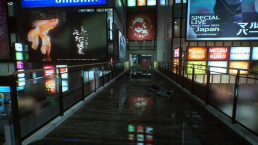

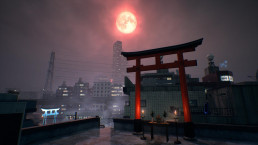
Despite its original angles, Ghostwire still falls for a well-known pitfall: after a while the stretch is a bit out. The narrative passages, which usually take place in closed environments, are considerably stronger towards the end than the open world. After all, in the closed environments there are boss fights and a lot of paranormal activities are played that completely turn the environments upside down.
In the open world, which at first is so beautiful to explore, the endless confrontations with ghosts at some point become a routine job. You pop some fireworks from your fingers, pull the core out of your enemies in a spectacular way, and can continue again. Three blocks away, the same scenario awaits you.
It also doesn’t help that you unlocked all your powers quite early in the game. New skills can still be unlocked via a standard skill tree, but they mainly make your existing powers slightly stronger. Visually nothing changes and you don’t have to press any other buttons.
It’s a shame that Ghostwire already loses its powder in the first half of the game, because the game really has tons of originality to offer. For example, it was nice that you hear KK’s voice not only through all your speakers, but also through your controller. Normally I’m not a fan of audio through the controller, but in this case it makes KK’s voice completely ‘surround’ you, as if it were really a voice in your head. The controller’s speaker is also used to pick up some sort of noise when ghosts are around, which gives a pretty eerie feeling every time.
In any case, the audio is of a high level. Attacks from enemies, for example, really fly right past your head, but also while exploring Shibuya you can place a dog’s barking or a cat’s meowing quite well in space. Why is that important? Well, Shibuya’s animals can help you in many ways. Plus, you can pet and feed them! That alone is reason enough to go after animal sounds.
I can still fill paragraphs with fantastic details from Ghostwire: Tokyo, or anecdotal side missions that you find in the city, but I especially recommend that you discover all of that yourself. Tango Gameworks shows with verve that they can not only make gore horror, but can also pick your brain with paranormal horror. They can also create a beautiful game world. Making that game world fascinating to the end is only an improvement for their next game.
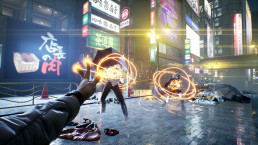
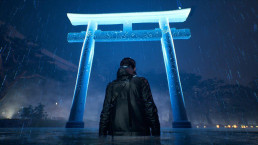
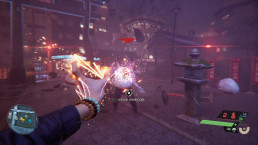
Conclusion:
Ghostwire: Tokyo is bursting with originality and also looks great. Still, that can’t prevent that typical open-world game routine creeps in towards the end of the game.
Ghostwire: Tokyo will be available on March 25 for PlayStation 5 and PC. For this review, the game was played on the PS5.
Score:
9,0
+ Very intriguing and unique setting
+ Top notch audio
+ Shibuya is beautifully crafted
+ Original combat system
– Very repetitive towards the end of the game.
Review | Horizon Forbidden West
Even in places in the game world where hardly anyone goes, Aloy is recognized in Horizon Forbidden West. The first thing she hears? “If it isn't the Savior of Meridian!” Well, Aloy saved the world in Horizon Zero Dawn and the world has not gone unnoticed. Yet it is almost as if everyone has collectively forgotten that the world's greatest hero is simply called Aloy.
In any case, the Amsterdam Guerrilla Games is not. The studio celebrates its best character in Forbidden West as sequels rarely do. Aloy is the heart and soul of this game. It’s heartwarming to meet her old friends, remember adventures from the first part, and see how everyone in the world has heard about Aloy’s exploits. No one doubts her ability.
Aloy herself thinks otherwise. Uncomfortably and hesitantly, she waves the compliments away in Forbidden West. Savior of Meridian? “Just call me Aloy.” She says it over and over. That aversion has little to do with a latent impostor syndrome. Aloy doesn’t feel like a heroine because she knows what’s to come. In Zero Dawn she learned who she really is and what her role is in the game world. The real work has yet to begin.
The beginning of Forbidden West elaborates on the events of the previous part. After that, the game starts to juggle more and more jargon. That’s one of Horizon’s strengths – the world derives its depth from it. At the same time, that makes the story inaccessible. If you’ve never played Zero Dawn or have forgotten much of the story, I recommend checking out this refresher on YouTube.
Zero Dawn’s story was good, but it only really spurred on after a big reveal halfway through the game. Forbidden West goes wild earlier, but still takes a hefty run-up. The game starts in a defined area, similar to Assassin’s Creed: Valhalla. The first few hours are a bit of a pull, but once in the West, the game gets going right away.
A certain tribe then throws the bat in the henhouse and it is probably up to Aloy to knit everything to a good end. Unsurprisingly, Forbidden West is about much more than clans and their plotlines, which are once again bursting with political twists and animosity. Still, I did not expect that there was still so much to tell about this game world.
Guerrilla Games has been far from open-handed in Horizon Zero Dawn. Forbidden West has plenty of surprises in store.
Partly because of all those twists, this game has a wonderful flow. You really fly through the story. The loaded main missions continue to deepen the world in new ways, while stories within side missions are often worthwhile too. Some side missions even pick up on the overarching storyline and introduce characters who will play a role later on.
The motion capturing of those characters is also sublime. People gesture happily and have recognizable manners. The facial animations are also very well done. The contrast with some plastic left off Zero Dawn is truly colossal. Certain characters have gotten a little more attention than the minor roles, but overall the animation and voice work is top notch.
The actors have had enough source material, because Forbidden West is bursting with dialogue. Sometimes you are listening for minutes. Despite the aforementioned excess of jargon, the writing is sharp and at times even surprisingly funny. You will not be laughing in your living room, but the humor is well dosed and different ’types’ within the cast are used well.

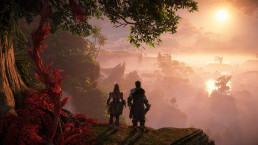

The story deserves all the praise and, together with the game world, is continuously intriguing. Playing a hunter-gatherer in a post-post-apocalyptic world makes the Horizon series completely unique. That is also ironic in a way, because the open world activities themselves are slightly less unique. Forbidden West is sort of a compilation album of everything you know from open world games.
You have the towers from Assassin’s Creed, the outposts from Far Cry, the question marks from The Witcher, the glider from Zelda: you know it by now. The structure of the game world is the same as in Zero Dawn. It’s not like Forbidden West is suddenly mimicking the freedom of Breath of the Wild. No, you are still going through question marks on the map or scrolling through missions in a menu. “You know” is not an overstatement in that sense.
That is by no means a criticism, let that be clear. While Zero Dawn could have been a linear game according to some critics, Forbidden West benefits a lot from the variety of an open world. That’s because there are more diverse activities that are actually fun to do. The side missions in particular have improved enormously. They introduce entertaining scenarios and some unique environments.
For example, mild platform puzzles regularly play a role during side missions. Aloy can now climb mountain walls, a bit like Breath of the Wild, but only in the case of certain rocks. Sequences like this are really, really fun. The Cauldron Caves are certainly platform highlights. Those almost Ratchet & Clank-esque levels are bursting with spectacular running and flying action.
A little less impressive about the platforming is the erratic controls. Aloy sometimes forgets to extend a reaching hand prior to a jump. Several times I swore back to the beginning of a platform section. It turns out that you have to wait until Aloy extends that hand. That takes some getting used to.
Speaking of which: I also had to get used to the mounts in this game. On the one hand they go fast and that is great, but too often you are braked because you get stuck behind a rock or a protruding branch. In addition, it is difficult to estimate which rivers you can or cannot cross, depending on how deep they are.
This is inconvenient, but also manageable over time. You get used to it. You have to, because the game world is so vast that sometimes you can’t do without your mount, especially if you can’t fasttravel for a while. The Forbidden West is huge. You travel a lot of lonely miles to get everywhere.



This game world is bursting with different types of environments and one by one they are indescribably beautiful. The distant vistas and exposure form a sort of scenic tandem. I fell silent for a moment as the morning sun rose over the mountains for the first time to paint the landscape red.
What steals the show in particular is the art design. In the environment where the game starts, that’s not too bad, because everything takes place in a small canyon. But gosh, once you get to the West, the sequel unfolds in ways I can barely explain. How this game blends old (modern technology) and new (a world full of indigenous tribes) is spectacular from start to finish.
One minute you’ll be amazed at the tribes and their authentic cities; fifteen minutes later, you’re gazing at a half-collapsed space center, fighter jets overgrown by moss and colossal carcasses of machines that blend into the mountain landscape. So consistent, so unique, so much detail: this is an absolute masterclass in art design, also underwater.
The pop-in is minimal and the frame rate constant, at least on the PlayStation 5. It is recommended to play the game at the highest frame rate (60). The resolution is then lower, but you don’t notice that much, probably partly due to post-processing. Of course you can play the game with all the bells and whistles at the highest resolution, but then you have to take into account a frame rate that does not exceed 30.
And that’s inconvenient, because the recognizable and satisfying action can certainly be very hectic against big opponents. In addition, Aloy’s knee slide deserves an honorable mention. Aloy can slide on her knees on the ground for many meters – even longer when going downhill. While she is sliding, you can adjust her very accurately, for example around corners. It’s a small mechanic, but oh my gosh, it feels good.
Horizon Forbidden West introduces more such adjustments that feel good right away, but don’t seem significant in themselves. Take the fine checkpoints, more extensive skill trees, nicer upgrades for your weapons or the smooth fasttravel. The critic will then say: With such adjustments, Forbidden West does not change the rules of the open world genre.
Correct. In fact, Forbidden West doesn’t do that anyway, not even compared to other Sony games.
Ghost of Tsushima includes more subtle tricks to guide you through the game world, such as the wind showing the way and animals showing you where to go. Forbidden West is a more traditional open world game, one that relies on quest markers and menus with commands like its predecessor. You are not guided through the world ‘automatically’. Exploring mainly means going into question marks on the map.
It doesn’t matter at all. It’s obvious that Guerrilla Games wants to bet with Forbidden West on everything that makes Horizon Zero Dawn fun and unique. The result is a very trimmed sequel where you rarely do anything you don’t feel like doing. Forbidden West is captivating to follow, fun to play and beautiful to watch across the board. And to think that this gaming year has practically yet to begin.
Horizon Forbidden West is available on February 18 on PlayStation 4 and PlayStation 5. We played the game on a PlayStation 5.
Conclusion: Better, smoother, better written, phenomenal art design, a consistent story, more surprises and better main and side missions: Horizon Forbidden West is better than its already sublime predecessor Horizon Zero Dawn on almost every front. Big kudos to Guerilla games, homegrown pride!
Score:
9,5
+ Beautiful game world with sublime art design
+ Entertaining and varied missions
+ Story full of revelations and surprises
– Minor cosmetic flaws
– Platforms don’t always run smoothly.
Review | Deathloop
What if every day were the same? Of course that would quickly become boring. But what if every day were the same on an island full of heavily armed idiots who only party and beast because there are no consequences anymore? Then you get something that is anything but boring. Then you get Deathloop.
The concept of Deathloop is simple: the island of Blackreef is engulfed in a time loop for an unknown reason. Everyone wakes up every morning to do the exact same thing, no matter what happened the previous day. Although the city’s residents are aware of the time loop and thus drink, party and stunt as if tomorrow does not exist, no one has memories of what happened the previous day. Except Colt and Julianna. As a player, you start out as Colt, who finds out that he can break the time loop by killing a number of specific targets within one day. But if you die yourself, the day starts all over again.
Does that make Deathloop a roguelite? Not quite. So don’t be put off by the idea of ’permadeath’. In Deathloop, to begin with, you have not one, but three lives per time loop. If you really do die, you usually retain a lot of progression and sometimes even weapons, upgrades and supernatural powers, such as the ability to teleport. On the other hand, even if you don’t die, the time loop just restarts when the virtual day is over.
The time loop is therefore more than a simple game mechanic. It’s a fundamental part of the game. The ultimate goal is to kill all targets within one run, but that’s easier said than done. Blackreef is subdivided into four areas and the day is also divided into four parts of the day. You can only visit one area per day part, and your actions also influence the rest of the day. If Hitman is chess, then Deathloop is chess on four boards at once.
A simple example, there is a fireworks factory that is destroyed by a fire every afternoon. Unless you interrupt the power supply to the factory in the morning, so that the fire can never take place. But beware, the fireworks factory will burn down again the next day if you don’t intervene again that day. Knowledge is therefore your greatest weapon. Little by little you puzzle together what to do and what not to get all the targets in exactly the right place, so that you can kill them all in one day.
Because of that setup, dying is rarely frustrating, even if you might lose a super cool weapon. Deathloop isn’t about trial & error, it’s about learning more and more about the game world. You discover a new shortcut, overheard an interesting conversation and now learned something about a target, or managed to ‘Infuse’ a weapon with the interdimensional stuff Residue so that you have it in your arsenal the next day to sit. And if you don’t have enough Residue, at least you now know where and when you can find that weapon again. Every run you make progress in one way or another. The time loop isn’t a curse, it’s a blessing that makes you smarter and stronger. While everyone starts the same routine over and over, you are the only one who knows what will happen and how you can influence the course of events.

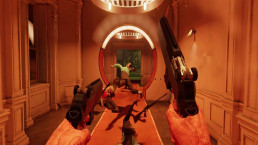
Or at least, almost alone. In addition to being Colt, you can also play as Julianna, the only other person who remembers things. While Colt is trying to break the time loop, Julianna tries to defend the time loop. When you play as Julianna, you invade other players’ game. Your only goal then is to annoy the other player. The fun part is that you have no idea how heavily armed or experienced that other player is. Besides, Colt has three lives, but Julianna only has one. So you are at a disadvantage and have to work smarter. For example, you can disguise yourself as a regular NPC to be less noticeable. After some practice, the undersigned even managed to imitate walking routes of an NPC, after all, the NPCs do exactly the same every day. The unsuspecting Colt looked up badly when he thought he was stalking a stupid NPC and was suddenly treated to a shot of hail from close range. But beware, Juliannas from all over the world regularly invade your game.
It is a bit questionable how much stretch there is in the ‘multiplayer’ of Deathloop. As Colt you really do finish the game at some point, while as Julianna you can basically go on indefinitely. So over time, more people will want to play as Julianna than as Colt and of course that’s not possible. As a Colt, you can also disable multiplayer so other players can’t invade your game. By the way, you are not rid of Julianna, because if you go offline, a computer-controlled nemesis will regularly disrupt your game. That battle between Colt and Julianna is simply a fundamental part of Deathloop.

The titular time loop and everything around it is undoubtedly Deathloop’s main achievement, but it’s certainly not the only thing that makes the game so intriguing. After all, Arkane Studios wouldn’t be Arkane Studios if the game world in itself wasn’t incredibly interesting to explore. The world of Deathloop is bizarrely detailed. The 60s aesthetic with organically shaped furniture and washed out colors blends perfectly with a touch of retrofuturism, but that clearly wasn’t unique enough for Arkane.
The island itself is a crazy collection of eccentric locations. Even if you have a number of time loops on it, the environment continues to excite and there are always new things to discover. On top of old military bunkers and concrete complexes, luxurious villas, dance clubs and an arcade hall. There is a kind of open air fair where it is a surprise with every building what is behind the front door, and a castle has been converted into a real life shooting game. Blackreef is a kind of anarchic amusement park and Arkane Studios knows how to convincingly create every attraction.
Arkane even manages to convey the feel of each weapon through the adaptive triggers of the DualSense controller. With the clunky machine gun aptly named Pepper Mil, for example, you feel the recoil in the trigger with each individual bullet. Together with the absurdly fine and genuinely funny voiceover, this is yet another example of a carefully worked out detail with which Arkane Studios goes beyond itself.
Yet we get the feeling that the game world could have been just a little more beautiful. On the PlayStation 5 you unfortunately have to choose between stable 60 fps, ray tracing at 30 fps, or some sort of in-between with nicer graphics without ray tracing and a more unstable frame rate. Because timing and reflex are so essential for a silent killer, in our opinion Performance Mode is the only serious option in practice, but then you miss some graphical bells and whistles.
The only other point of criticism is the somewhat saltless ending, about which we can say little without spoiling it. So we will not go into that further. You could say that the journey there is more exciting than the destination. But hey, by the time you get to that destination, you’ll have found more than enough reasons to include Deathloop in your Game of the Year shortlist.
Deathloop is now available for PlayStation 5 and PC. For this review, we played the game on PlayStation 5.
Score:
8,5
+ Admirably detailed game world
+ Tantalizing until the end
+ Very strong voice acting
+ Excellent balance
– The multiplayer part can dry up quickly
– Game’s ending leaves little impression
Review | Cyberpunk 2077
It's hard not to dwell on the beautiful images that Cyberpunk 2077 constantly presents you. Night City, the city where most of the game takes place, feels alive and very real. The architecture, the horizon: it looks like a city with a history. A city where buildings and streets are built on the remains of previous constructions, and where roads and alleys wind organically around existing structures.
The way the story is propelled, whether in the main mission or in the many, many optional side missions, is fantastic. Conversations give you information organically, and during those conversations you make choices that actually affect later events and even the end of the game. The choice of your life path as the mercenary V , Corpo, street rascal or Nomad, at the start of the game not only determines how the game starts for you, but also gives you dialogue options that suit your background.
Just like in most modern RPGs, completing a mission consists of several stages, in which you have to make all kinds of choices. Many missions consist of “heists”, complicated infiltrations where you stealthily, fight or hack to reach a goal. You decide how to tackle a problem at any time. For example, it is often possible to complete missions without firing a shot, which is not only blood-curdling, but also very satisfying. You use your common sense instead of your weapons. However, if you just want to knock things over, you can of course do as you please.
Finally, hacking is primarily a useful tool that adds an interesting puzzle element to confrontations with enemies. The hacking itself is not very challenging, it’s in fact nothing more than a kind of maze that you have to solve by selecting letter-number combinations before the time runs out. Once something or someone is hacked, on the other hand, new doors open to deal with a situation.
Somewhere early in the game, a gigantic, heavily armed cyborg, for example, seemed almost impossible to defeat. But by hacking him before the fight, there was suddenly the option of either blinding him, making his giant arm cannon a lot less effective, or knocking out half of his life meter with a powershortage.

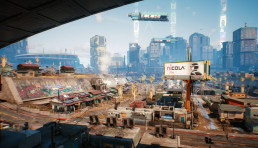
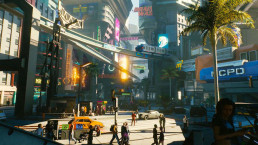
Fighting as well as sneaking are not without problems. Well, “problems” may be a bit heavily phrased, but Cyberpunk 2077 is pretty forgiving on that front. When an enemy spots V, you have a few seconds to move out of sight again. Which is remarkable, given that the vast majority of opponents have cybernetically enhanced eyes.
The same is true to some extent for gunfights. You can do a lot of damage even in the beginning of the game and it is by no means always necessary to move tactically from cover to cover to win a fight. In fact, when an enemy is hiding behind a pillar, it’s a lot more effective to run up to it and shoot a shotgun in the face a few times.
Fortunately, that tactic doesn’t always work, and when there are many enemies in the area, it’s certainly possible to quickly go “flatline”, Cyberpunk 2077’s version of a game over-screen. Which also immediately causes another minor annoyance: checkpoints do not always make sense. For example, in a given mission, the game saves before a long dialogue scene, which is followed by a spirited firefight. So it is not possible to manually save the game during a battle or a dialogue. Having to go through the same scene with interactive options multiple times therefore diminishes its emotional impact.
Fortunately, there is a feeling of excitement and fun during most of the game. Especially when the first act is over and you meet Johnny Silverhand, the virtual rock star who is suddenly implanted in your brain due to circumstances. Johnny acts as your side kick in the same way that The Joker was in Batman: Arkham Knight. He shows up to comment on you and the situation and usually acts like an amusing bastard.
It’s also thanks to Johnny that Cyberpunk 2077 elevates itself to a game that truly belongs in the cyberpunk genre. Because to be “real” cyberpunk, it is not enough to create a technological city with implants and virtual reality. The great strength of the genre is that this dystopian vision of the future poses interesting questions about what it means to be a human, and about life and death. And especially by adding alienating elements. The character Johnny, played brilliantly by Keanu Reeves, is the epitome of those traits. From the moment Johnny gets into “your” head, Cyberpunk 2077 transforms from “a game of cyberpunk decoration” to something with a strong identity of its own.
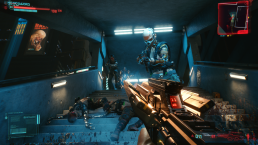
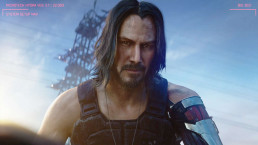

Cyberpunk 2077 is basically a standard role-playing game with stats, levels, skill upgrade points and a quest log full of missions that you collect along the way.
Missions are classified by “danger level”, which basically shows if your level is high enough to survive them. There are extremely many of these side missions to be found. Of course, there are a lot of trivial activities, such as taking out criminals for their bounties or collecting objects, but many of the “real” side missions are just as extensive and full of surprises as the main story. In that respect, we again see the philosophy of the studio that brought us The Witcher 3: side missions are actually the reason to play. The main story itself is not very long. It is possible to complete it in twenty hours by ignoring most of the side paths.
Although there is a certain routine in tackling missions (sneak, fight, hack your way through a location) the game isn’t predictable. In addition to the fact that later upgrades change your playing style substantially, there are also all kinds of trips that refresh things considerably. Trips such as an underwater mission and various “brain dances”, where you step into a memory and play a kind of mini adventure game to collect clues, provide plenty of unpredictability. Most missions also have certain surprises, where you suddenly have to solve a puzzle unique to that mission.
The game did not crash with us, but there are some small bugs. The day one patch should fix a lot, and given the extensive support for The Witcher 3, it’s not unreasonable to expect Cyberpunk 2077 to be near bug-free in a few months. Which makes it feel like it might be a bit of a shame to play the game right now. But yes, the hype and all that. This is such a game that many people look forward to and want to get into as soon as possible.
Hype is a bad counselor. Looking forward to a game for eight years will give that game a mythical status that it can never live up to. That doesn’t mean it is bad. Cyberpunk 2077 is a really, really good RPG in a great world.
Score:
9,0
+ Lots of variety
+ Lots of good story missions
+ Great graphics
– Unnecessary bugs
